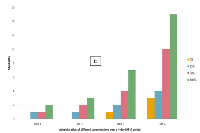Ecotoxicological effects of pharmaceutical waste in selected water bodies in Lagos state, Nigeria on Amietophrynus regularis tadpoles
Keywords:
Pollution, Pharmaceuticals, Toxicity, TadpolesAbstract
The discharge of pharmaceutical effluents into nearby water bodies could constitute hazard to the environment because they contain toxic substances detrimental to health. Over 50% of pharmaceutical companies in Nigeria are domiciled in Lagos state, Nigeria. This study investigated the presence of selected pharmaceuticals in some water bodies in proximity to pharmaceutical companies within Lagos State and toxicological effects of pollution. Water samples were collected from three water bodies in Lagos environment located close to pharmaceutical companies: their physicochemical parameters were assessed and selected pharmaceutical residues were quantified using HPLC/UV detector. Acute toxicological effects of the contaminated water samples were assessed in the common African toad (Amietophrynus regularis). The results revealed the presence of levofloxacin (0.19 µg/ml), chloroquine (1.21 µg/ml), acetaminophen (7.52 µg/ml), metformin (4.83 µg/ml) and ibuprofen (3.27 µg/ml) in the water samples. Dissolved oxygen values were consistently low in all the locations sampled (0.90-2.58 mg/L) and elevated COD and BOD levels. In the 96 h acute toxicity study of water samples A, B and C, mortality occurred in tadpoles over a period of 96 h, LC50 values of were 33.5 %, 42.17 % and 37.58 % respectively. Results obtained showed that avoidance response was highest in sample B and lowest in sample C. The presence of pharmaceuticals in the water bodies located close to pharmaceutical companies may pose adverse consequences on the environment. There is therefore a need for the treatment of pharmaceutical waste-water before discharging into the environment.
Downloads
References
Adeoye, G. O., Alimba, C. G. and Oyeleke, O. B. (2015). The genotoxicity and systemic toxicity of a pharmaceutical effluent in wistar rats may involve oxidative stress induction. Toxicology Reports, 2: 1265-1272.
Agunbiade, F. O. and Moodley, B. (2014). Pharmaceuticals as emerging organic contaminants in Umgeni River water system, KwaZuluNatal, South Africa. Environmental Monitoring and Assessment, 186(11): 7273-7291.
Akaahan, T.J.A., Olabanji, F.M. and Azua, E.T. (2015). Studies on contamination of surface waters of river Benue with trace elements at Makurdi, Benue State, Nigeria. Journal of Environmental Chemistry and Ecotoxicology, 7(5), 49-55.
American Public Health Association (APHA), American Water Works Association and Water Environment Federation (1998). Standard Methods for the Examination of Water and Wastewater 20th Edition. United Book Press, Inc., Baltimore, Maryland 3111, 3-13.
Andersson, D.I. and Hughes, D. (2014). Microbiological effects of sublethal levels of antibiotics. Nature Reviews Microbiology, 12(7), 465.
Arnold, K. E., Brown, A. R., Ankley, G. T. and Sumpter, J. P. (2014). Medicating the environment: assessing risks of pharmaceuticals to wildlife and ecosystems. Philosophical Transactions of the Royal Society: Biological Sciences, 369(1656): 20130569- 20130580.
Aus der Beek, T., Weber, F. A., Bergmann, A., Hickmann, S., Ebert, I., Hein, A. and Küster, A. (2016). Pharmaceuticals in the environment--Global occurrences and perspectives. Environmental Toxicology and Chemistry, 35(4): 823-35.
Awodele, O., Adewoye, A. A. and Oparah, A. C. (2016). Assessment of medical waste management in seven hospitals in Lagos, Nigeria. BMC Public Health, 16(1): 1-11.
Bakare, A. A., Okunola, A. A., Adetunji, O. A. and Jenmi, H. B. (2009). Genotoxicity assessment of a pharmaceutical effluent using four bioassays. Genetics and Molecular Biology, 32(2), 373–381.Miraji et al., 2016
Bakare, A. A., Okunola, A. A., Adetunji, O. A. and Jenmi, H. B. (2009). Genotoxicity assessment of a pharmaceutical effluent using four bioassays. Genetics and Molecular Biology, 32(2): 373–381.
Bowe, L. (2009). Investigating Emergent Contaminants: Pharmaceutical impacts and possible solutions. Retrieved 22nd November, 2017 from www.mass.gov/eea/docs/dep/toxics/stypes/ec-bowe.doc.
Brodie Jr, E.D. and Formanowicz Jr, D.R. (1983). Prey size preference of predators: differential vulnerability of larval anurans. Herpetologica, 67-75.
Byrne, J. A., Fernández-Ibáñez, P. and Sharma, P. K. (2016). Water Scarcity in Developing Regions. In Sustainable Water Management, Chen David (Ed.), CRC press, Boca Raton, 1, chapter 9, 227-248.
Cardoso, O., Porcher, J. M. and Sanchez, W. (2014). Factory-discharged pharmaceuticals could be a relevant source of aquatic environment contamination: review of evidence and need for knowledge. Chemosphere, 115, 20-30.
Ebele, A. J., Abdallah, M. A. E. and Harrad, S. (2017). Pharmaceuticals and personal care products (PPCPs) in the freshwater aquatic environment. Emerging Contaminants, 3(1), 1-16.
Ezemonye, L. I. N. and Ilechie, I. (2007). Acute and chronic effects of organophosphate pesticides (Basudin) to amphibian tadpoles (Ptychadena bibroni). African Journal of Biotechnology, 6(13), 1554-1558.
Ezemonye, L.I.N. and Tongo, I. (2009). Lethal and sublethal effects of atrazine to amphibian larvae. Jordan J Biol Sci, 2(1), 29-36.
Harbi, K., Makridis, P., Koukoumis, C., Papadionysiou, M., Vgenis, T., Kornaros, M., Ntaikou, I., Giokas, S. and Dailianis, S. (2017). Evaluation of a battery of marine species-based bioassays against raw and treated municipal wastewaters. Journal of Hazardous Materials, 321, 537-546.
Hayden, M.T., Reeves, M.K., Holyoak, M., Perdue, M., King, A.L. and Tobin, S.C. (2015). Thrice as easy to catch! Copper and temperature modulate predator‐prey interactions in larval dragonflies and anurans. Ecosphere, 6(4), 1-17.
Kolpin, D. W., Furlong, E. T., Meyer, M. T., Thurman, E. M., Zaugg, S. D., Barber, L. B. and Buxton, H. T. (2002). Pharmaceuticals, hormones,
and other organic wastewater contaminants in US streams, 1999− 2000: A national reconnaissance. Environmental Science and Technology, 36(6), 1202-1211.
Kostich, M. S., Batt, A. L. and Lazorchak, J. M. (2014). Concentrations of prioritized pharmaceuticals in effluents from 50 large wastewater treatment plants in the US and implications for risk estimation. Environmental Pollution, 184: 354-359.
Küster, A. and Adler, N. (2014). Pharmaceuticals in the environment: scientific evidence of risks and its regulation. Philosophical Transactions of the Royal Society: Biological Sciences, 369(1656): 20130587.
Liu, J. L. and Wong, M. H. (2013). Pharmaceuticals and personal care products (PPCPs): a review on environmental contamination in China. Environment International, 59: 208-224.
Lohdip, Y. N. (2013). River and Stream Water Quality Monitoring in North Central Zone-Niger: Challenges and Solutions. Proceedings of the 1st Regional Workshop organized by National Water Capacity Building Network, North Central Regional Centre (NWRCBNet-NC), University of Ilorin held 3rd and 4th December, 2013.
Loos, R., Carvalho, R., António, D. C., Comero, S., Locoro, G., Tavazzi, S., Paracchini, B., Ghiani, M., Lettieri, T., Blaha, L. and Jarosova, B. (2013). EU-wide monitoring survey on emerging polar organic contaminants in wastewater treatment plant effluents. Water Research, 47(17): 6475-6487.
Ngumba, E., Gachanja, A. and Tuhkanen, T. (2016). Occurrence of selected antibiotics and antiretroviral drugs in Nairobi River Basin, Kenya. Science of the Total Environment, 539, 206-213.
Ngwuluka, N. C., Ochekpe, N. A. and Odumosu, P. O. (2011). An assessment of pharmaceutical waste management in some Nigerian pharmaceutical industries. African Journal of Biotechnology, 10(54), 11259-11264.
Obasi, A. I., Amaeze, N. H. and Osoko, D. D. (2014). Microbiological and Toxicological Assessment ofPharmaceutical Wastewater from the Lagos Megacity, Nigeria. Chinese Journal of Biology, 2014(1): 1-1.
Olaitan, O. J., Anyakora, C., Bamiro, T. and Tella, A. T. (2014). Determination of pharmaceutical compounds in surface and underground water by solid phase extraction-liquid chromatography. Journal of Environmental Chemistry and Ecotoxicology, 6(3): 20-26.
Olarinmoye, O., Bakare, A., Ugwumba, O. and Hein, A. (2016). Quantification of pharmaceutical residues in wastewater impacted surface waters and sewage sludge from Lagos, Nigeria. Journal of Environmental Chemistry and Ecotoxicology, 8(3): 14-24.
Olatunde, O. J., Olatunbosun, O., Olatunde, A., Anyakora, C. and Christopher, K. (2014). Occurrence of Selected Veterinary Pharmaceuticals in Water from a Fish Pond Settlement in Ogun State, Nigeria. International Journal of Environmental Monitoring and Analysis, 2(4), 226-230.
Relyea, R. A. (2010). Multiple stressors and indirect food web effects of contaminants on herptofauna. In Ecotoxicology of amphibians and reptiles (Second edition), Sparling D., Linder G., Bishop C. and Krest S. (Eds). Society of Environmental Toxicology and Chemistry Press, Pensacola, Florida, USA, 75–486.
Reeves, M. K., Perdue M., Blakemore G. D., Rinella D. J. and Holyoak M. (2011). Twice as easy to catch? A toxicant and a predator cue cause additive reductions in larval amphibian activity. Ecosphere 2: 72.
Smith Jr, J. S. (2014). Presence and fate of pharmaceuticals in the environment and in drinking water. Pharmaceutical Accumulation in the Environment: Prevention, Control, Health Effects, and Economic Impact, Ed. Goldstein W. E., CRC press, Taylor and Francis group, London, Chapter 3, 21-42.
United States Geological Survey (USGS) (2002). Pharmaceuticals, Hormones, and Other Organic Wastewater Contaminants in US Streams. USGS Fact Sheet FS-027-02.
Von der Ohe, P. C. and de Zwart, D. (2013). Toxic Units (TU) Indicators. In: Encyclopaedia of Aquatic Ecotoxicology. Férard, JF and Blaise C. (Eds.) Springer, Dordrecht, Netherlands, 1161 –1170.
Wilcox E (2013). Pharmaceuticals in the environment: review of current disposal practices for medications and the influence of public perception on environmental risks. Environmental Assessment. Accessed 12th November, 2017.
Zhang, Z., Wang, B., Yuan, H., Ma, R., Huang, J., Deng, S., Wang, Y. and Yu, G. (2016). Discharge inventory of pharmaceuticals and personal care products in Beijing, China. Emerging Contaminants, 2(3): 148-156.

Downloads
Published
Issue
Section
License

This work is licensed under a Creative Commons Attribution-NonCommercial-ShareAlike 4.0 International License.







